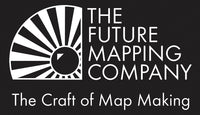The Women Who Shaped The World
Would it surprise you to know that on Wikipedia's list of cartographers - of the 200+ names, just 2 are women?
Historically, there have been many challenges for the female cartographer to face. Much mapping was done from ships which banned women; and universities were closed to women which cut off another avenue. However, many cartographic businesses were family-run and women often worked as engravers, colourists and more, it’s just that their contribution has mainly gone unrecognised.
Here are our Top 10 Favourite Female Cartographers:
1. The Nuns at Ebstorf
The Ebstorf Map (ca 1234) is the largest known mappa mundi – a European medieval map. Less a navigational tool, it is full of religious and ethnographic information, measures 12ft and is illustrated on 30 goatskins. Scholars disagree as to who the author of the map really is. Originally thought to have been created by Gervase of Ebstorf, many others now think it contains too many dissimilar traits and was actually co-created by the nuns of Ebstorf famed for their craft(wo)manship in the Arts.

2. Shanawdithit (ca. 1801 – 1829)
Shanawdithit was the last of her tribe, the Beothuk people of Newfoundland, Canada. The tribe was intentionally eradicated by British settlers, so she was forced to live with William Cormack, as some form of servant, although it was he who encouraged the detailed drawings she made of her people’s territory.
Recalled from memory they showed an astounding level of topographical detail. Cormack said: “one of these sketches represents about one hundred miles of the Exploits River including part of Red Indian Lake, the whole of which is contained on one sheet of foolscap. If the scale were to be judged of by the width of the river or lake, it could not be less than six inches to a mile; nevertheless, every fall, rapid and tributary or other remarkable feature is laid down, all of which I have no difficulty in recognising from my own exploration and survey of 1875.”

3. Florence Kelley (1859 – 1932)
An ardent socialist (and translator of Engels), Florence Kelley was a social and political reformer who campaigned for children’s and workers’ rights in early 20th Century Chicago. Commissioned to inspect factories and survey urban slums, she set about creating maps of Chicago showing demographic information that could be used to campaign for change. Like John Snow’s cholera map these maps were not only technically brilliant, they helped improve the lives of those in poverty.

4. Phyllis Pearsall (1906 – 1996)
Creator of London’s famous A to Z, Phyllis was a formidable cartographer, publisher and entrepreneur. We love her so much we’ve written a longer piece about her, which you can read here.

5. Judith Tyner (b. 1938)
Professor Emerita of Geography at California State University where she taught for over 35 years, Judith Tyner is a one woman cartographical powerhouse whose interests include map design, women in cartography and the theme that most interests us – “persuasive cartography”.
She introduced the concept of "persuasive cartography" in the mid-1960’s to better understand the subjectivity inherent in map making, proposing that “one can explore the assumptions and ideologies that enter maps even before they are made”. As author William van den Hoonaard says “take city maps. You might not see bus stops marked on the map because men are not the prime user of buses. Clinics, schools, playgrounds will often be indicated in lighter colors.. A hockey rink might have its full name on the map; a playground may not.” We had never considered the inherent prejudice in map-making so this was real food for thought for us!
6. Kira B Shingareva (1938 - 2013)
Shingereva was a professor at Moscow State University and Principal Scientist at the Laboratory of Comparative Planetology at the Institute of Space Research. Shingareva was one of the first people to succeed at mapping the dark side of the moon – an incredible achievement if you think about it!
Shingareva’s main collaborative project with her colleagues was the creation of the Atlas of Terrestrial Planets and their Moons (1992), the preparatory work for which took 12 years and, rather sweetly, she is commemorated by the Lunar crater Kira, named by her American colleagues.
7. Regina Araujo de Almeida (b. 1949)
Professor of Geography at the University of Sao Paulo in Brazil, Regina Araujo de Almeida is the world’s leading cartographer in tactile mapping. Tactile maps use texture and relief to enable the teaching of geography to visually impaired people – for example embossed paper maps might have a raised area for landmass, different textures for water and Braille for place names. A side of map-making that most of us wouldn't ever know existed.

8. Marie Tharp (1920 - 2006)
Tharp was an American oceanographic cartographer who created the first scientific map of the ocean floor, in partnership with Bruce Heezen. Her work contributed significantly to the theory of continental drift as it showed the Mid-Atlantic Ridge. Their collaboration with Austrian painter Heinrich Berann, led to the publication of their map in 1977. Their dedication to the task, unorthodox ways, and an overzealous University Director, lead to them completing the project at home: “the off-campus mapping project eventually took over every room in Tharp’s house. The upstairs master bedroom held a flatbed table, larger than a king-size bed; the Indian Ocean took shape during one phase, the Pacific in another". True dedication to the cause!

9. Mary Spence, MBE
The UK’s foremost female cartographer, Mary Spence, spent over 30 years making maps before being awarded an MBE in 2004 for Services to Cartographic Design. Her most recent award-winning map 'The Dynamic World', depicts natural phenomena such as earthquakes, tsunamis, volcanoes and areas at risk of global warning - a lesson to us all.

10. The Unknown Cartographer
Much like the tomb of the unknown soldier, we dedicate our final position to all the unknown women who worked in mapping in the war, such as this anonymous contributor: “During the war I worked in the Ordnance Office... Usually only men were allowed to draw maps... I was working on maps of the coastlines of France and Germany and maps of large towns in Germany e.g. Bremen, Hamburg etc. I now realise that we were working on maps to bomb those towns. Now it seems terrible!”
And from a male colleague: “I worked on the Ordnance Survey in Hinchley Wood from March 1943 until I joined the RE Survey in 1944. There were hundreds of drawing and photowriting people there and most were female. What bothered me was that these ladies… were better at it than me. It was a relief to join the army”.



